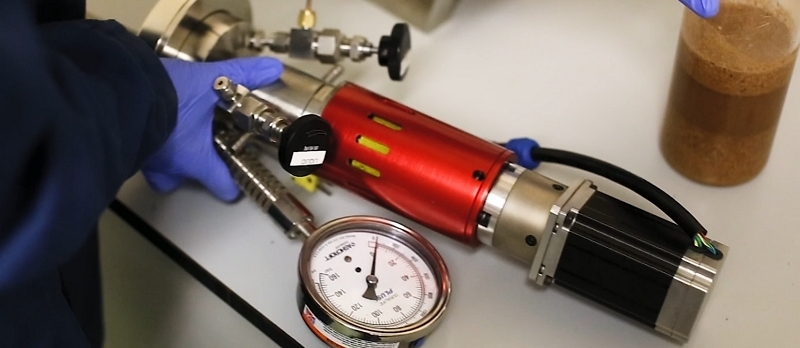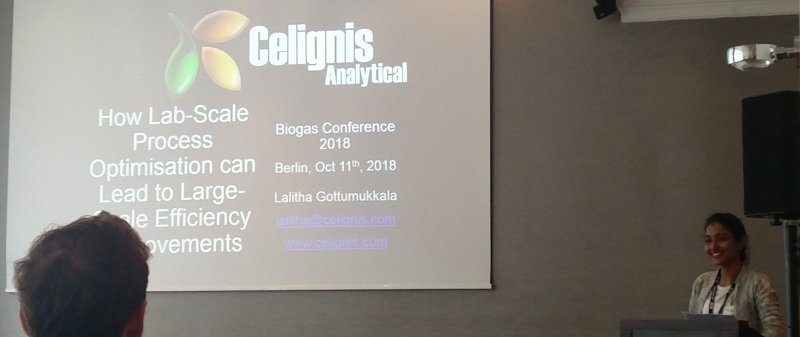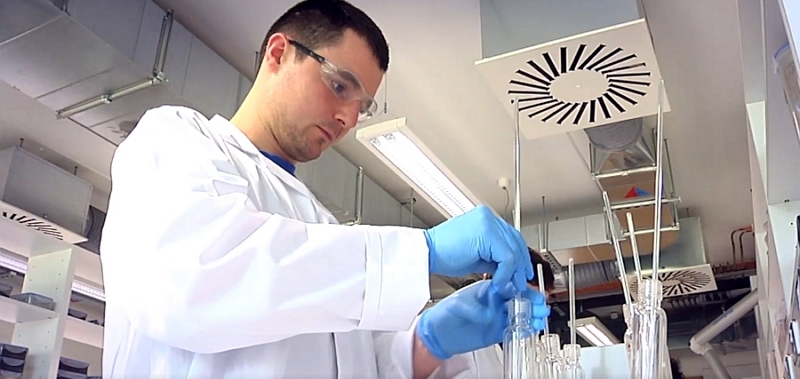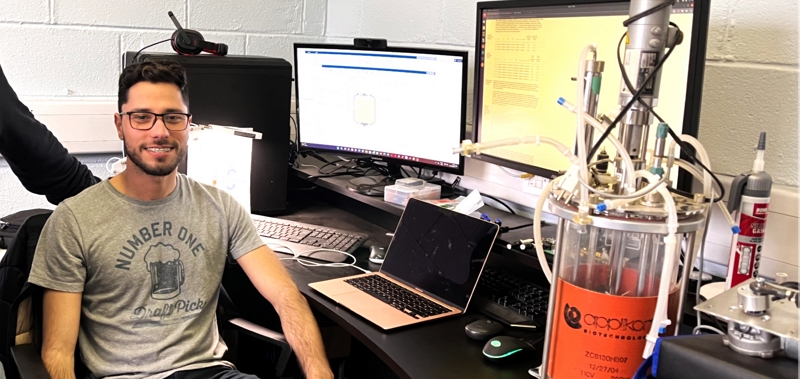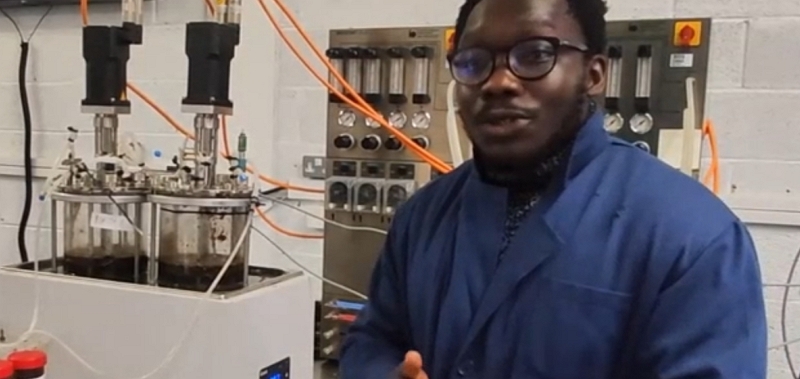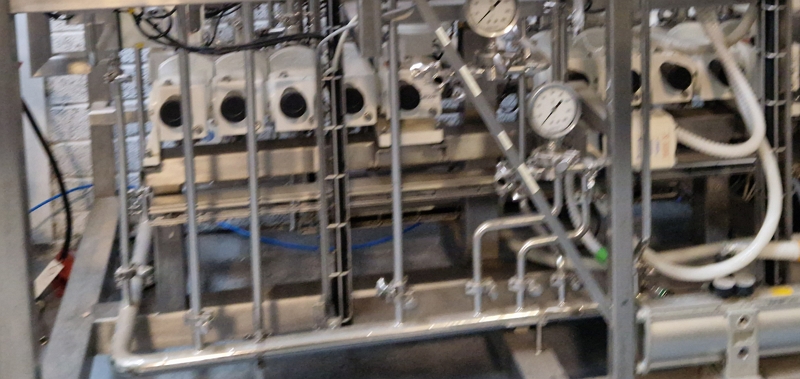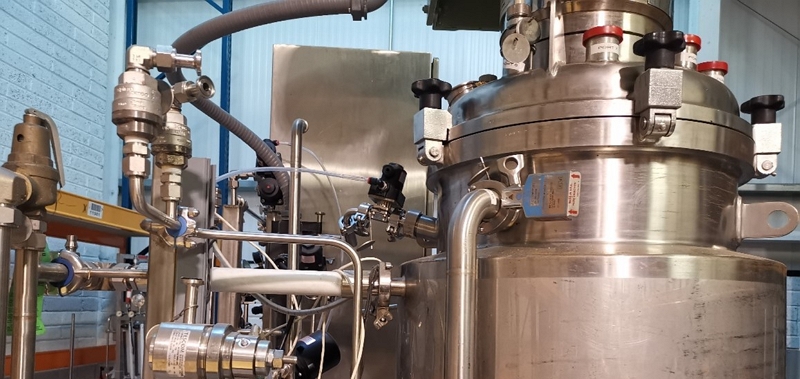Concentrated-Acid Hydrolysis of Lignocellulosic Biomass
Lignocellulose Hydrolysis
Lignocellulosic biomass, primarily comprised of cellulose, hemicellulose, and lignin, is an abundant and renewable resource that holds great promise as a source of biofuels and renewable biobased chemicals and biomaterials. Lignocellulosic biomass can be processed in a number of ways, one is through the hydrolysis of the structural polysaccharides (cellulose and hemicellulose) into their constituent sugars, a reaction commonly facilitated by acid or enzymes, followed by the fermentation of these sugars by yeast or other microorganisms.Click below to read more about the hydrolysis of lignocellulosic biomass.
Get more info...Biomass Hydrolysis
Acid Hydrolysis
Hydrolysis of lignocellulose can be catalysed with acids. These can be used in either dilute or concentrated forms, with each approach having its own advantages and disadvantages.Different process intensities are required for the hydrolysis of cellulose versus hemicellulose. The more intense conditions required for cellulose hydrolysis may degrade the sugars hydrolysed from hemicellulose (to products such as furfural and formic acid)
Concentrated-Acid Hydrolysis
Concentrated-Acid Process
Concentrated acid hydrolysis, unlike its dilute counterpart, involves the use of acids in high concentrations to disrupt and hydrolyse the complex polysaccharides (cellulose and hemicellulose) present in lignocellulosic biomass into simpler, fermentable, sugars. The most commonly used acid in this process is sulphuric acid due to its strong acidity, but other types of acids (e.g. hydrochloric acid) can be used.The first stage of the process targets hemicellulose and involves the treatment of biomass under relatively mild conditions. It leverages the fact that hemicellulose is less crystalline and more readily hydrolysed than cellulose. In this stage, the biomass is soaked in concentrated acid, typically at room temperature, over a period ranging from minutes to hours, depending on the specific process parameters and the nature of the biomass. The aim is to hydrolyse hemicellulose into monomeric sugars while minimizing the degradation of these sugars and leaving the cellulose component largely intact.
Following this stage, the mixture is often subjected to a separation step where the acid, along with the hydrolysed hemicellulose sugars, is drained off and separated from the solid residue, which is primarily composed of cellulose and lignin. The removal of hemicellulose sugars at this point reduces the risk of their degradation in the subsequent, more intense, hydrolysis stage.
The second stage of concentrated acid hydrolysis is geared towards the hydrolysis of cellulose. This phase typically involves more severe process conditions compared to the first stage, including a higher temperature and a longer reaction time. Despite the increased severity, the conditions are still milder than those typically used in dilute acid hydrolysis.
Following the second stage, the mixture undergoes another separation step where the acid and hydrolysed sugars are separated from the residual solids, which are predominantly lignin. The recovered acid can be reused in the process, while the sugars can be used in further donwstream processing, for example for the production of bioethanol via fermentation.
Effect of Process Conditions
The efficiency and output of concentrated acid hydrolysis are heavily influenced by several key process variables, detailed below:- Acid Type - The type of acid used can significantly impact the efficiency of hydrolysis. Sulphuric acid is the most commonly used acid due to its strong acidity and ability to efficiently hydrolyze both cellulose and hemicellulose. Other acids (e.g. hydrochloric acid and phosphoric acid) can also be used but may not offer the same efficiency. The choice of acid can also affect the formation of byproducts. For instance, sulphuric acid can lead to the formation of sulphur-containing compounds that may be inhibitory to subsequent fermentation.
- Acid Concentration - The concentration of acid used is a critical parameter. High acid concentrations can achieve high hydrolysis rates and complete conversion of cellulose and hemicellulose to sugars. However, very high acid concentrations can also lead to increased sugar degradation, resulting in the formation of undesirable byproducts like furfural and HMF. Therefore, the acid concentration must be carefully optimized to achieve efficient hydrolysis while minimizing sugar degradation.
- Temperature - The reaction temperature greatly affects the hydrolysis rate and the stability of the sugars produced. Higher temperatures can increase the hydrolysis rate, allowing for faster and more complete conversion of polysaccharides into sugars. However, high temperatures can also enhance sugar degradation and the formation of inhibitory byproducts. Therefore, the temperature is also usually optimised to achieve a balance between efficient hydrolysis and minimal sugar degradation.
- Reaction Time - The duration of the hydrolysis process can significantly affect the yields and quality of the resulting sugars. Longer reaction times can lead to more complete hydrolysis of the biomass. However, if the reaction is allowed to proceed for too long, especially under high acid concentrations and temperatures, it can lead to increased sugar degradation.
- Solid-to-Liquid Ratio - The ratio of the biomass to the acid (solid-to-liquid ratio) can also affect the hydrolysis efficiency. A higher ratio can lead to higher sugar concentrations in the resulting hydrolysate, which can be beneficial for downstream processes like fermentation. However, very high ratios can also hinder efficient mixing and heat transfer during hydrolysis, potentially leading to incomplete hydrolysis.
- Biomass Type and Composition - The type and composition of the biomass can significantly affect the hydrolysis efficiency and the quality of the resulting sugars. For instance, biomass with high hemicellulose contents may require different hydrolysis conditions compared to biomass with high cellulose contents. Furthermore, the presence of compounds such as lignin and extractives can affect the hydrolysis process and the formation of byproducts. Therefore, the hydrolysis conditions often need to be tailored based on the specific characteristics of the biomass.
Advantages
- High Efficiency - One of the main advantages of concentrated acid hydrolysis is its high efficiency. The approach is capable of breaking down virtually all the cellulose and hemicellulose components of lignocellulosic biomass into fermentable sugars. This near-complete conversion is a significant advantage as it allows for maximal sugar yields from a given quantity of biomass, making the process highly effective for biomass valorization.
- No Enzyme Requirement - Concentrated acid hydrolysis does not require the use of costly enzymes, which can represent a significant portion of the operating costs in enzymatic hydrolysis methods. This can potentially lead to substantial cost savings, especially for large-scale operations. Furthermore, the avoidance of enzymes simplifies the process, removing the need for enzyme production, storage, and handling steps.
- Lower Operational Temperature - The process typically operates at lower temperatures compared to dilute acid hydrolysis. This can reduce the energy requirements of the process, leading to further cost savings and reducing the environmental footprint of the operation. Additionally, the reduced thermal stress can potentially extend the lifespan of the process equipment, resulting in lower maintenance and replacement costs.
- Versatility - The process is versatile and can be applied to a wide range of lignocellulosic biomass types, including both hardwoods and softwoods, agricultural residues, and energy crops. This flexibility allows it to be adapted to use locally-available or low-cost biomass feedstocks, contributing to the economic feasibility and sustainability of the process.
- Reduced Sugar Degradation - Under properly-controlled conditions, concentrated acid hydrolysis can lead to reduced sugar degradation compared to dilute acid hydrolysis. By performing the hydrolysis in two stages, with hemicellulose and cellulose hydrolysed separately under optimised conditions, the process can minimize the exposure of sugars to harsh conditions that can lead to their degradation. This can result in higher sugar concentrations in the hydrolysate and improve the efficiency of the subsequent fermentation process.
- Potential for Acid Recovery - Although the recovery and reuse of acid represent a significant challenge in concentrated acid hydrolysis, they also offer a potential advantage. If implemented effectively, acid recovery can significantly reduce the acid consumption of the process and contribute to its economic and environmental sustainability. It can also reduce the challenges associated with the disposal of acid-containing wastewater.
Disadvantages
- Acid Recovery and Neutralisation - One of the main challenges associated with concentrated acid hydrolysis is the necessity for acid recovery and neutralisation. After hydrolysis the resulting hydrolysate contains a high concentration of acid which needs to be neutralised before the solution can be used for fermentation. This neutralisation step typically involves the addition of a base, which can result in the formation of large amounts of salts. These salts can pose challenges for downstream processes and waste disposal. Furthermore, due to the high acid concentration used in the process, a significant portion of the process cost is tied up in the acid. Hence, recovery and reuse of the acid is critical for the economic feasibility of the process. However, acid recovery is a complex process that can add to capital and operating costs.
- Corrosiveness - The high concentration of acid used in the process is highly corrosive, which imposes requirements for corrosion-resistant materials in the process equipment and infrastructure. This can significantly increase the capital costs of the process. Furthermore, the corrosive nature of the process can lead to higher maintenance and replacement costs over the lifetime of the facility.
- Sugar Degradation - While concentrated acid hydrolysis can potentially lead to reduced sugar degradation compared to dilute acid hydrolysis, the risk of sugar degradation is still a significant challenge. Under the harsh conditions used for cellulose hydrolysis a portion of the sugars can degrade into byproducts (e.g. furfural and HMF). These compounds are not only lost products but can also be inhibitory to many fermentation organisms, affecting the efficiency of subsequent fermentation.
- Environmental Impact - The high acid consumption and the need for acid neutralisation can lead to a high environmental footprint of the process. The production and disposal of acids can have significant environmental impacts. Furthermore, the formation of large amounts of salts during acid neutralisation can pose challenges for wastewater treatment and disposal.
- Complexity - Concentrated acid hydrolysis is a complex process that requires careful control and optimisation of process parameters. The two-stage process, involving separate hydrolysis of hemicellulose and cellulose, requires multiple separation and acid-recovery steps. This complexity can lead to higher capital and operating costs compared to simpler hydrolysis methods.
1. Understanding Your Requirements
Prior to undertaking bioprocess projects we learn from our clients what their targets are from the process as well as whether there are any restrictions or requirements that may need to form the boundaries of the work that we undertake. These help to guide us to then prepare a potential bioprocess development project.
2. Detailed Feedstock Analysis
In cases where you have already selected a feedstock for the bioprocess, we would then undertake a detailed compositional analysis (P10 or, ideally, P19) of representative samples of that feedstock.
In cases where the feedstock has not yet been selected we can review your list of candidate feedstocks, selecting top candidates based on our prior experience in their analysis and bioprocessing. If you do not have a list of candidate feedstocks then we can provide one, based on your location and the requirements outlined in Stage 1. We would then analyse in detail these priority feedstocks and come to a decision, based on the compositional data and other relevant factors (e.g. price, supply, consistency etc.) on a selected feedstock for the project.
At this point of the project, the Celignis Bioprocess team typically meet to discuss and prepare a project proposal for the development of a concentrated-acid hydrolysis bioprocess from this feedstock. After this proposal is reviewed by the client, and revised if needed, we are then ready to start work on the next stages.
3. Hemicellulose Hydrolysis
Given the different process severities required for hemicellulose and cellulose hydrolysis, it is likely that the first stage of the process will be focused on optimising conditions for the hydrolysis of hemicellulose. Hence, this stage of the project will involve undertaking a number of concentrated-acid hydrolysis experiments, covering a variety of process conditions, targeting the desired products of hemicellulose hydrolysis. We follow a scientifically-based Design of Experiments (DoE) protocol where the criteria and boundaries for this DoE are formulated in close collaboration with our clients, considering the chemistry of the feedstock(s) and our understandings of the mechanisms of biomass hydrolysis.
For each experiment we analyse the solid and liquid outputs of the process, leading to a detailed data-set where effects of process conditions on the yield and composition of the various streams can be explored and mapped. We usually recommend that these initial optimisation experiments are undertaken at the lab-scale (around TRL3) in order to reduce costs and the length of the project.
We can also undertake a second iteration of lab-scale experiments in order to fine-tune the conditions based on the knowledge gained in the initial experiments.
For this step in the bioprocess it may also be necessary, depending on the composition of the feedstock, to undertake a prior step where the extractives are removed. This is because extractives may negatively interfere with the mechanisms of acid-catalysed hydrolysis of hemicellulose, leading to lower yields of the targeted products and the formation of more unwanted byproducts. Click here to read more about bioprocess development for the removal of extractives from biomass.
4. Cellulose Hydrolysis
This Stage of the bioprocess will be focused on the concentrated-acid catalysed hydrolysis of the solid residue obtained from Stage 3. As in that Stage, this work will involve evaluating the effects of varying a number of different process conditions (e.g. solid-loading, acid-type, acid concentration, temperature, reaction times, mixing) via a detailed DoE being undertaken. This work will allow these conditions to be narrowed-down in order that the objectives of the hydrolysis, outlined in Stage 1, can be met.
It is likely that the solid residue being processed in this Stage will mostly be composed of cellulose and the parts of lignin that were not released into the liquid phase in Stage 2. There may also be small amounts of residual unhydrolysed hemicellulose in the solid residue. The target of the concentrated acid hydrolysis of this residue is the efficient hydrolysis of cellulose to glucose. If the glucose is then required as a substrate for subsequent fermentation then another major objective of this Stage would be a minimisation of the production of compounds that could inhibit this fermentation.
As with Stage 3, it is recommended that the optimisation experiments in Stage 4 are undertaken at the lab-scale in order to accelerate the outputs and reduce project costs.
This stage usually follows Stage 3, however it is possible that there can be some overlap in order to reach the final project outputs more quickly.
5. Downstream Processing
As described earlier, the use of concentrated acids requires careful process optimisations with regards to: the separation of the solid and liquid streams; the recovery of the acid; and the neutralisation (and potential detoxification) of the hydrolysate so that the liberated sugars can be further processed. Hence, this stage of the project will look at optimising each of these processeṣ.
Additionally, this Stage will also developed optimisied approaches for the downstream valorisation of the liberated sugars obtained from Stages 3 and 4. Processes can be developed to valorise each of these liquid streams separately or a combined treatment can be developed. For example, if the main focus of the project is on the production of bioethanol from cellulose in the highest yields possible, then fermentation may be optimised using just the cellulose-derived sugars, with a separate process considered for the liquid output stream from Stage 3. However, if there is a preference for a simpler process (i.e. less process nodes), then a process that co-ferments hexose and pentose sugars (i.e the combined liquid streams from Stages 3 and 4) may be optimised even if this might lead to lower bioethanol yields from cellulose. Once again, this work would involve a carefully-formulated DoE with the experiments undertaken at the lab-scale level.
It is possible for this Stage to run alongside Stage 4.
6. Product Recovery
Based on the outputs of the prior lab-scale Stages we can optimise the methods employed for separating and purifying the target products from the liquid phases.
It is possible for this Stage to run alongside Stage 5.
7. Valorisation of Remaining Biomass
Where concentrated-acid hydrolysis is employed for both the hydrolysis of cellulose and hemicellulose, the remaining solid biomass after the cellulose-hydrolysis step (Stage 4) is likely to contain much of the lignin as well as any unhydrolysed cellulose and any humin products that may have been formed along the way.
We can undertake a number of different analyses and experiments to determine the best route for valorising this residue. For example, we can evaluate its suitability for combustion.
8. Validation at Higher TRLs
Once we have concluded our optimisation of the concentrated-acid hydrolysis process conditions at the lab-scale we can then test those conditions at higher technology readiness levels (TRLs). The scales at which we can operate are dependent on the type of technology employed, but can reach up to 100 litres.
We have all of the necessary downstream equipment to efficiently handle the solid and liquid streams arising from these scaled-up activities.
If we find that there are differences between the yield and compositions of the different streams, compared with our lab-scale experiments, then we can explore the potential reasons for these and work on final tweaks to optimise the bioprocess for higher TRLs.
9. Technoeconomic Analysis (TEA)
The Celignis team, including Oscar our chief TEA expert, can undertake a detailed technoeconomic analysis of the developed process. We apply accurate and realistic costing models to determine the CAPEX and OPEX of simulated and pilot scale processes which are then used to determine key economic indicators such as IRR, NPV and payback periods.
Within these TEAs we can undertake sensitivity analyses to assess the effect of variable costs and revenues on the commercial viability of the process.
Our preferred approach is to include TEA studies at each stage of the development of the bioprocess, so that the process can be optimised in a commercially-relevant way, followed by a more detailed TEA after the process has been optimised and tested at higher TRL levels.
Click here to read more about the technoeconomic analysis (TEA) services offered by Celignis.

Lalitha Gottumukkala
Founder of Celignis Bioprocess, CIO of Celignis
PhD
<p style="text-align: left;">Has a deep understanding of all biological and chemical aspects of bioproceses. Has developed Celignis into a renowned provider of bioprocess development services to a global network of clients.</p>

Oscar Bedzo
Bioprocess Project Manager & Technoeconomic Analysis Lead
PhD
<p style="text-align: left;">A dynamic, purpose-driven chemical engineer with expertise in bioprocess development, process design, simulation and techno-economic analysis over several years in the bioeconomy sector.</p>

Dan Hayes
Celignis CEO And Founder
PhD (Analytical Chemistry)
<p style="text-align: left;">Dreamer and achiever. Took Celignis from a concept in a research project to being the bioeconomy's premier provider of analytical and bioprocessing expertise.</p>


